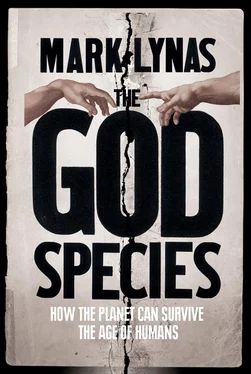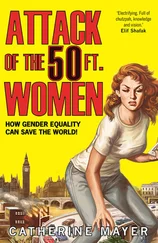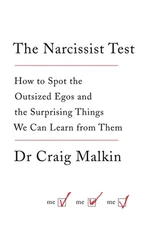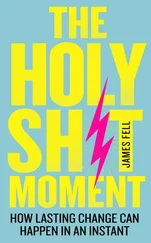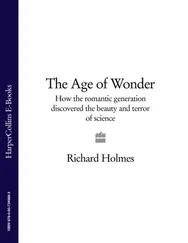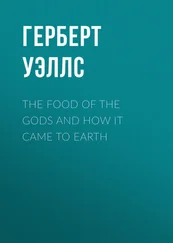But this world also had a dark side, for several simulations illustrated that the flaw in self-regulation – the time gap between a disturbance and the evolved correction – might occasionally be fatal. In just a few model runs, an organism appeared that was so spectacularly successful in mopping up nutrients that its numbers exploded and its wastes built up to toxic levels before other organisms were able to evolve a response. Williams and Lenton dubbed these occasional rogue species ‘rebel organisms’. They were unusual, but their impact was invariably catastrophic: the explosive initial success of the rebels changed the simulated global environment so suddenly and dramatically that their compatriots were killed, and – with no other life-forms around to recycle their wastes – they were themselves condemned to die too. As the last lonely rebels perished, their whole biosphere went extinct, evolution ceased, self-regulation failed, and life wiped itself out.
Like Lovelock’s Gaia, Flask world – and its rebel organisms – might just be a clever idea, more of a metaphor than a true representation of reality. But the parallels with our species are unsettling. We have transformed our environment within just a few centuries in ways that are wiping out other life-forms at a shocking speed – the changes so rapid that evolution has no time to adapt and thereby allow other organisms to survive. Like a rebel organism, our species discovered a colossal new source of energy, which had lain hidden and undisturbed for millions of years, and which no previous life-form had found a use for. It is the sheer rapidity in the rise of the waste from the exploited new energy source of buried carbon – largely in the form of gaseous carbon dioxide – plus the other combined wastes and environmentally transformative impacts that fossil fuels allowed humanity to achieve, that have now begun to overwhelm the self-regulatory capacity of the Earth system. This single element holds the key to a possible future mass extinction.
Flask world is now our world. Consider that our wastes are accumulating so fast in the oceans that no species can consume them; instead, massive dead zones are spreading around the world’s coasts, from China to the Gulf of Mexico, where the recent BP oil spill adds to the toll. We have produced novel organic chemicals and synthetic polymers that no microbes have yet learned to digest, and which are poisonous to most organisms – often including ourselves. And we are steadily eating our way through global biodiversity – from fish to frogs – consuming voraciously, and moving on to the next species when one is extinguished. Those species that are not edible we ignore and displace, whilst those that threaten or dare to compete with us we pursue mercilessly and annihilate. Thus is our rebel nature revealed.
There is a paradox however. Even as a putative rebel organism, humanity is a product of Darwinian evolution, like every other naturally generated life-form sharing our planet today. Moreover, we did not evolve the biological capacity to eat coal and drink oil – the energy from these abundant ‘nutrients’ is combusted outside the body rather than metabolised within it. Why us, then? Our mastery of fire was a product of the adaptability and innovativeness with which evolution had already equipped us long before, and that no other species had heretofore possessed. Humanity’s Great Leap Forward was not about evolution, but adaptation – and could therefore move a thousand times faster.
I don’t want to oversimplify: the Stone Age did not end in 1764 with James Watt’s invention of the steam engine. Clearly great leaps in human behaviour and organisation took place over preceding millennia with the advent of language, trade, agriculture, cities, writing and the myriad other innovations in production and communications that laid the foundations for humanity’s industrial emergence. But I would argue that the true Anthropocene probably did begin in the second half of the eighteenth century, for it was then that atmospheric carbon dioxide levels began their inexorable climb upwards, a rise that continues in accelerated form today. This date also marks the beginning of the large-scale production of other atmospheric pollutants and the planet-wide destabilisation of nutrient cycles that also characterise this new anthropogenic geological era.
Take population. When humans invented agriculture, some 10,000 years ago, the global human population was somewhere between 2 and 20 million 3 Конец ознакомительного фрагмента. Текст предоставлен ООО «ЛитРес». Прочитайте эту книгу целиком, купив полную легальную версию на ЛитРес. Безопасно оплатить книгу можно банковской картой Visa, MasterCard, Maestro, со счета мобильного телефона, с платежного терминала, в салоне МТС или Связной, через PayPal, WebMoney, Яндекс.Деньги, QIWI Кошелек, бонусными картами или другим удобным Вам способом.
. There were still more baboons than people on the planet. By the time of the birth of Christ, the globe supported perhaps 300 million of us. By 1500, that population had increased to about 500 million – still a relatively slow growth rate. A global total of 700 million was reached in 1730. Then the boom began. By 1820 we numbered a billion. That total rose to 1.6 billion by 1900, and the growth rate continued to accelerate. By 1950 we were 2.5 billion strong, and by 1990 had doubled again to more than 5 billion. In 2000 the 6 billion mark was passed. At the time of writing, in late March 2011, we number an astonishing 6.88 billion individuals. 4 Конец ознакомительного фрагмента. Текст предоставлен ООО «ЛитРес». Прочитайте эту книгу целиком, купив полную легальную версию на ЛитРес. Безопасно оплатить книгу можно банковской картой Visa, MasterCard, Maestro, со счета мобильного телефона, с платежного терминала, в салоне МТС или Связной, через PayPal, WebMoney, Яндекс.Деньги, QIWI Кошелек, бонусными картами или другим удобным Вам способом.
Through the process of writing this book, another 225 million people were added to the total – just under half the entire world population of 500 years ago, now appearing in just three years.
But this still doesn’t answer the puzzle: Why us? And why were buried stores of carbon the ‘nutrients’ that allowed our species to proliferate so explosively? A satisfactory response requires a brief digression into the evolutionary origins of this remarkable hominid, for it is our past that holds the key to our present and future. This is the story of a species whose biological characteristics combined with an accident of fate to have world-shattering consequences. And it is a story that might shed some light on the central question of this book – whether we are rebel organisms destined to destroy the biosphere, or divine apes sent to manage it intelligently and so save it from ourselves.
Perhaps the environmentalist and futurist Stewart Brand put it best when he wrote these words: ‘We are as gods and have to get good at it.’ 5 Конец ознакомительного фрагмента. Текст предоставлен ООО «ЛитРес». Прочитайте эту книгу целиком, купив полную легальную версию на ЛитРес. Безопасно оплатить книгу можно банковской картой Visa, MasterCard, Maestro, со счета мобильного телефона, с платежного терминала, в салоне МТС или Связной, через PayPal, WebMoney, Яндекс.Деньги, QIWI Кошелек, бонусными картами или другим удобным Вам способом.
Amen to that.
Читать дальше
